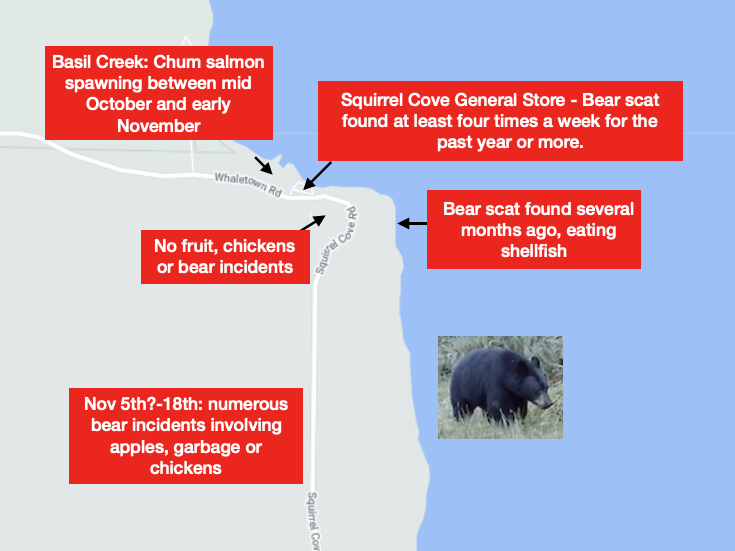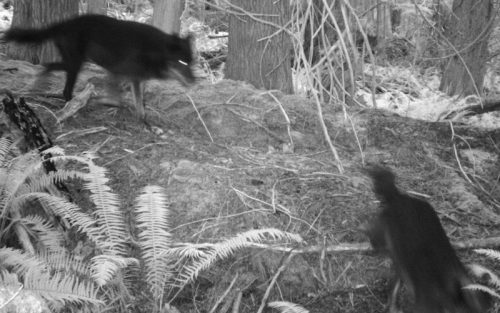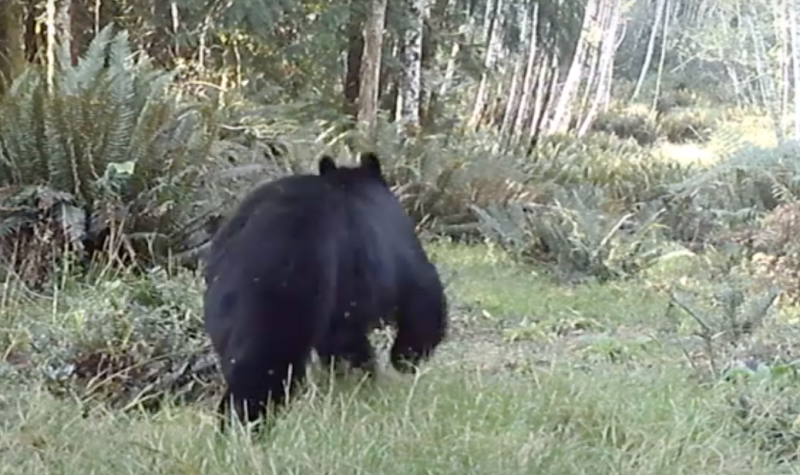By Roy L Hales
The question of coexistence with black bears has been raised once again as Cortes Island deals with recent bear raids.
“This is black bear country. It has always been black bear country. Northern Cortes Island is likely where most of the bears live. Black bears can travel very far in one day and they are good swimmers," said Autumn Barrett-Morgan, a volunteer co-ordinator with the Friends of Cortes Island’s wildlife COEXistence program.
"They do travel from island to island and there are likely year-round bears here. In the fall of 2019, there was a bear sighted at Blue Jay Lake. Then in April 2020, there was a black bear around Green Mountain. Since then, we’ve had conflicts with two bears: one in Whaletown and one in Squirrel Cove,” Barrett-Morgan added.
The Whaletown bear she mentioned was killed during the summer.
On Nov. 28, a conservation officer arrived on Cortes Island to trap the Squirrel Cove Bear.
“The Conservation Officer was called by someone in Squirrel Cove. This resident was feeling very fearful of the bear breaking into their home, so the Conservation Officer had no choice but to bring a trap here. Once the bear is trapped, it will be put down," Barrett-Morgan explained.

Image was adapted from Google Maps and a screenshot from Graham Blake’s Trail Cam video is included. Photo by Roy L Hales.
The Squirrel Cove Bear has been raiding a number of the houses, backing onto Basil Creek, for a little more than a month. The bear was drawn by the salmon return, but the inviting aromas of apples, compost and variety of other attractants nearby brought it onto human properties.
“At this time of year, a bear needs to eat 20,000 calories a day. We had a fairly good salmon return this year … and there is evidence of bears being down in Basil Creek. They have the best nose on the planet. They can smell up to a kilometre away and will eat anything they can get their paws on,” said Barrett-Morgan.
Was a human/bear conflict inevitable?
“No, this definitely did not have to happen, and could have been avoided. We need to be responsible and secure all attractants," said Barrett-Morgan.
“There is an abundance of year-round wild foods for bears on Cortes," she added. "There are roots and shoots in the Spring: like horse tails, skunk cabbage, sedges, grasses, nettles, dandelions and late spring salmon berries. Summer brings shrubs, grubs, insects and blackberries. Salmon runs are the #1 food source in the Fall along with green material in the estuaries. Year round, bears can eat in the intertidal zone feasting on barnacles, muscles, clams and crabs etc.
Barrett-Morgan added that the area has always bee "black bear country" because there are year-round food sources.
Bears follow their noses when searching for food and, unfortunately, this is what brought the bear into the Squirrel Cove residential area. It followed its nose to all the food waiting in the habitations backing onto Basil Creek.
“Once it was rewarded with apples, compost, bird feeders, fish fertilizer, etc. there became a conflict. The bear will keep returning to a spot where it knows it can get food. Bears are just trying to meet their caloric value, again of 20,000 calories, each day. On properties where the attractants were immediately secured, the bear did not return," Barrett-Morgan said.

Residents have managed to coexist with wolves on Cortes Island over time. Photo courtesy of the Friends of Cortes Island.
Coexisting with predators
The Friends of Cortes Island (FOCI) believe it is possible to coexist with predators, and they already have a proven track record with wolves.
“Many years ago, folks on the island had conflicts with wolves and lost pets to them. Again, it was an unawareness of the presence of wolves and how to co-exist with these creatures,” said Barrett-Morgan.
“These conflicts informed us on how to move forward and coexist with wolves. Eleven years later, we’ve reduced conflict so much that I, personally, have not heard of any in many years.”
FOCI drew up a five-point primer on how to live with wolves.
“It changes our perception of wolves too … When we have

The Friends of Cortes Island developed resources on coexisting with predators including "Learning to live with Bears on Cortes Island." Photo courtesy of the Friends of Cortes Island website.
conflicts it can be very overwhelming and frightening. As we’ve learned about wolves, their behaviour, and how to behave around wolves, we have learned how to coexist and live with wolves. It becomes more of a respectful relationship, respecting their space and wolves respecting residential spaces. I feel confident that we can learn this with bears as well.”
Prior to the human/bear conflicts, FOCI drew up a five-point bear primer this May, which is very similar to their existing primer for wolves.
“The Bear Primer was written and posted in May 2020… and it was edited by the senior provincial biologist and also endorsed by the Conservation Office Service. You can find the Bear Primer on the FOCI website: friendsofcortes.org. These are protocols that have been adopted by residents across the province because after all, we all live in bear country, and it is our responsibility to learn to coexist with wildlife,” said Barrett-Morgan.
Learning to live with bears on Cortes Island
NOTE: Content below is fully reposted from the FOCI website:
"We need to keep our bears WILD to ensure the safety of islanders and bears. Here’s what each of us can do to safely coexist and reduce human-wildlife conflict.
- Never feed bears and secure all bear attractants In BC, it is an offence to intentionally feed or leave attractants available to bears. Garbage is the #1 bear attractant; thoroughly wash all food/drink containers and packaging before placing in your garbage or recycling. Store garbage in a secure location inside; outside in bear resistant container/enclosure. Manage your compost properly; layer equal amounts of green (kitchen scraps/grass clippings) & brown (dried leaves/shredded paper) materials. Do NOT add fish, meats, oils, cooked foods or unrinsed eggshells; this is key to healthy, odour free composts. Clean BBQ’s after every use; burn grills & remove grease traps; remain odour free!!!
- Do not feed other wildlife – Bird-feeders often become BEAR-feeders; please only feed birds during the winter months. Alternatively, bird baths & native flowering plants will support local birds.
- Keep yourself safe – If you encounter a bear, DO NOT RUN; back up slowly, speaking in a loud but low voice; give the bear space and do NOT make eye contact. *When hiking/biking, travel in groups & keep talking to alert bears that you are there. Proactively carry bear spray (easily accessible, has not expired, know how to use it!). *If you have a bear in your yard, retreat into your house and observe what is attracting the bear, so it can be immediately removed after the bear has left.
- Keep your pets safe – Dogs must be leashed when walked; never walk dogs in areas w/ known bear activity. *Feed pets in a secure location INSIDE; keep your yard free of attractants, eg. bones. *Store pet food in secure location inside; outside in bear resistant container/enclosure.
- Practice good plant & animal husbandry – Harvest fruits from trees & bushes daily as they ripen; do NOT allow windfalls to accumulate on the ground. Proactively use electric fencing to protect your fruit crops. DILIGENCE around fruit crops is critical to prevent bears from hanging around and next discovering your vegetable garden… *Use electric fencing to protect livestock (includes bees) by day; proper installation & maintenance is key. By night, ensure livestock are in predator proof shelters. *Store all livestock feed in secure locations inside; outside in bear resistant container/enclosure and ensure livestock feeding areas are clean & free of attractants. *After butchering livestock, dispose of carcasses responsibly; buried deeply & well away from residential areas. Consider using electric fencing around food smokers & areas for preparing & curing wild meats."
“Guess what… Cortes Island IS black bear country!!! Report routine bear sightings to FOCI at 250 935 0087 or friendsofcortes@gmail.com; report bear encounters of concern to the COS at 1 877 952 RAPP (7277)," the website states.
Links of Interest
- (Cortes Currents) articles about, or mentioning, the Squirrel Cove Bear
- (Cortes Currents) Frequency of bear raids decreasing in Squirrel Cove
- (Cortes Currents) Squirrel Cove Bear Song: Bear in my bubble
- (Cortes Currents) The Squirrel Cove Bear
- (Tideline) Black Bear Activity in Squirrel Cove
- (Cortes Currents) articles about, or mentioning, the Whaletown Bear
- (Cortes Currents) Whaletown’s Black Bear
- (Cortes Currents) Coexisting with Black Bears on Cortes Island
- (Tideline) UPDATE on Black Bear Activity on Cortes Island
- (Tideline) UPDATE on Black Bear Activity in the Whaletown Area
- (Tideline) Black Bear Activity in Whaletown
- (Tideline) Guess What Folks… Cortes Island IS Black Bear Country
- (FOCI) Learning to Live with Bears on Cortes Island
- (Conservation Officer Service) Report All Poachers and Polluters (RAPP)
- (FOCI) Learning to Live with Wolves on Cortes Island


